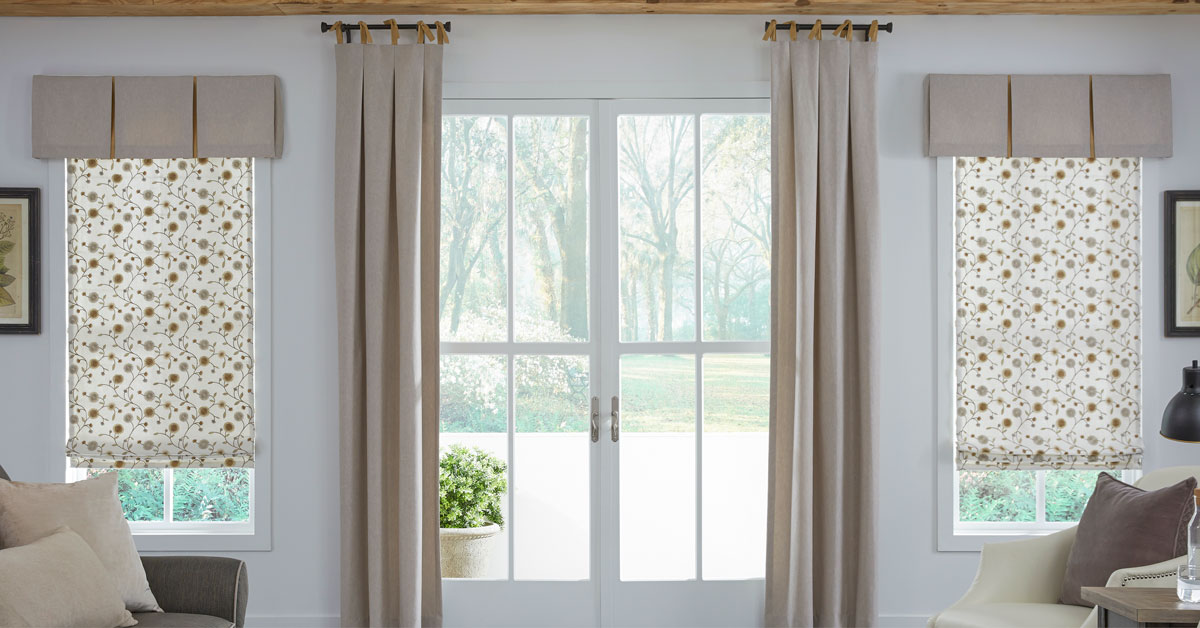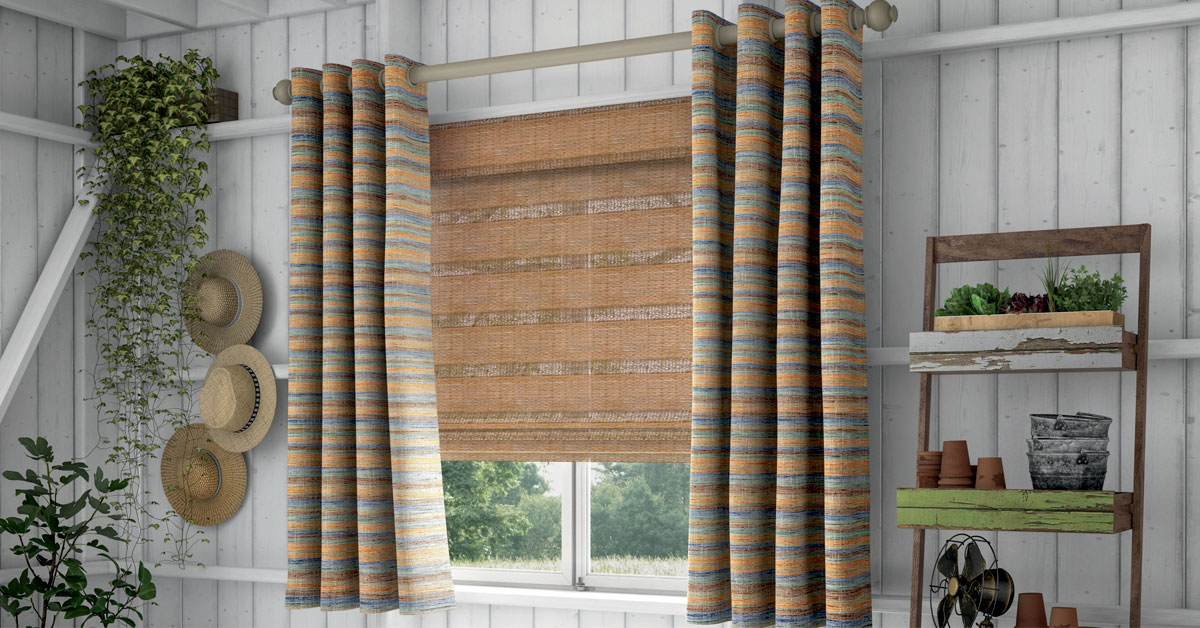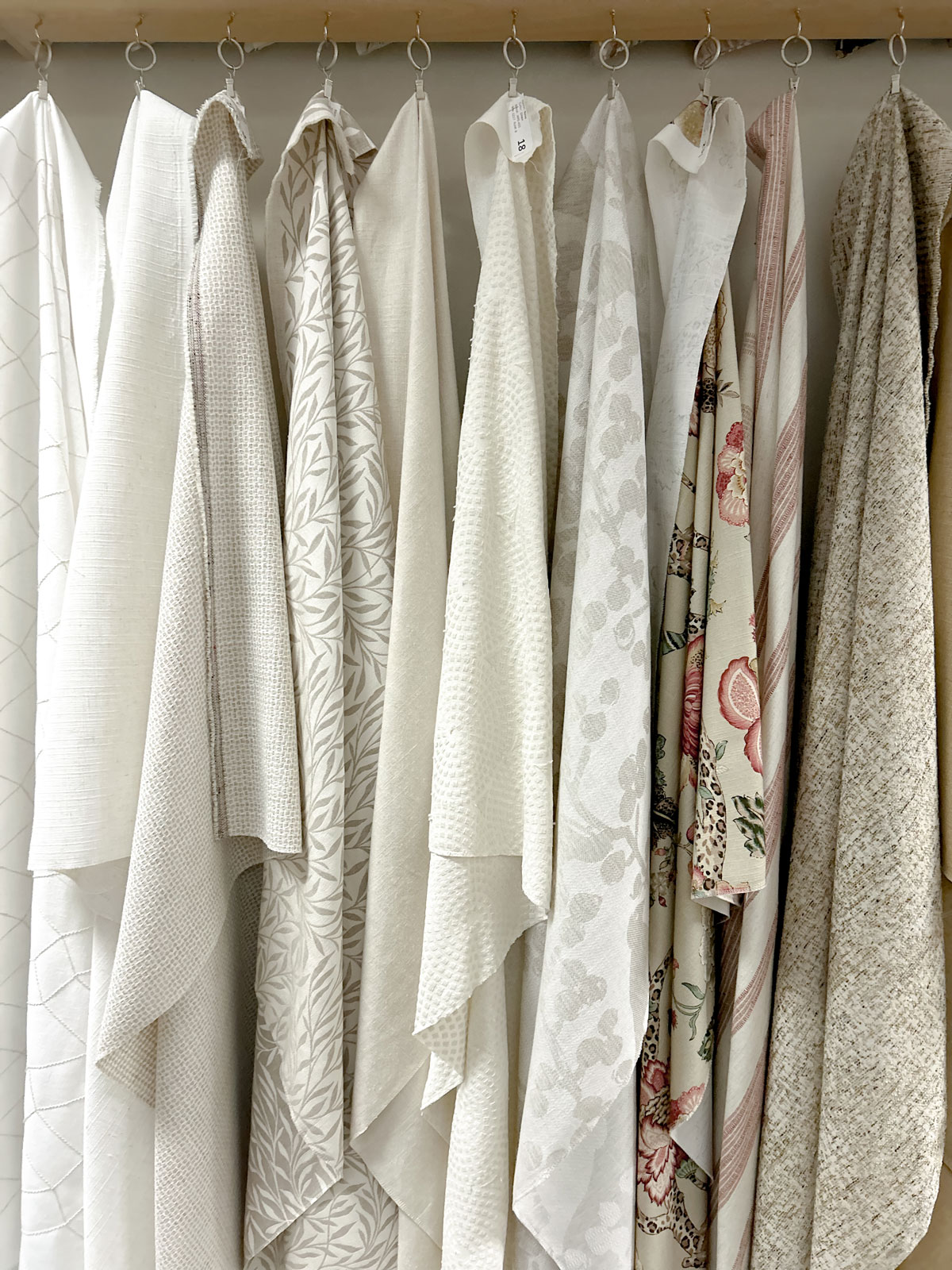
Choosing the Best Fabric for Your Drapery Project
Brooke Cleaver July 1, 2024
You’ve measured your windows and pored over various heading styles – only to be left with the agonizing choice of fabric selection. Draperies can be a wonderful addition to a home. But between all of the colors, patterns, and textures, the choice can be overwhelming. That’s why we’ve developed a system for choosing the most appropriate fabric for your application. Follow along to learn the ins and outs of fabric selection so that you can move forward with confidence.
The Importance of Fabric Choice
We know better than anyone how disappointing it can be when your dream project turns into a nightmare. Window treatments are an investment, so when things go south, it can leave us feeling anything but satisfied. This is why fabric selection matters. The success of a project comes down to more than just aesthetics. It depends on a multitude of factors, including:
- Your Personal Goals
- Fabric Content & Behavior
- Weight
- Application
This is why we’ve developed a comprehensive guide for fabric selection. So that no one is left feeling disappointed. Choosing the right fabric should be a rewarding process – enjoyable, even. So, without further ado, let’s dive into the steps so that you can select the best material for your style and application.

Defining your Goals
People hang draperies for a number of reasons. Some use them to shield their home from the elements, while others use them as a beautiful accent piece. So, what are your reasons? Are you looking for privacy and light control? Insulation, maybe? Or perhaps you’re more focused on enhancing the aesthetic appeal of your home? When it comes to draperies, there’s no one-size-fits-all approach. However, understanding your motivations can help to narrow down your search. So, let’s explore the most common reasons for hanging draperies – and how those objectives may influence your decision-making.
- Privacy: For many, draperies offer a sense of safety and protection. If privacy is your main concern, then you may want to consider opaque or semi-opaque options to guard your space from the outside world. Adding lining can further enhance these benefits.
- Light Control and Ambiance: Then there is the matter of light control. The opacity of a fabric can have a massive influence on the amount of light that enters a room. Sheer fabrics offer a soft, warm glow, while opaque fabrics block light. Lining can help further soften or block light.
- Climate Control: Draperies can be excellent tools for climate control, but the key lies in your choice of fabric. For effective insulation, opt for thicker fabrics with a tight, closed weave. Thinner fabrics with an open weave provide minimal protection against the elements.
- Aesthetic Appeal: Finally, the most common selling point for most draperies is their aesthetic appeal. With their long, clean lines and beautiful folds, draperies have a way of instantly infusing a space with character and charm. And if that’s your end goal – then the possibilities for weave, opacity, and style are virtually limitless.
Once you've defined your goals, you can begin exploring fabrics that align with those objectives. Select materials that enhance your space, ensuring they meet your functional needs and complement your aesthetic preferences.

Understanding Fabric Behavior
Now that you’ve defined your goals, let's discuss the fabric itself. One of the biggest mistakes people make is choosing fabric based on appearance alone. There's a vast difference between the aesthetic qualities of a fabric and its performative aspects. Drapery fabric is crafted from a myriad of fibers, each with unique characteristics. So, let's go down the line and examine the most common fabric types and their traits:
- Linen: This strong, lightweight textile is a popular choice amongst homeowners. Its natural composition and soft hand make it an ideal addition to any home. However, its flax-based design does lend itself to wrinkling. So, if you're not a fan of the casual, laid-back look of linen, then this breathable textile may not be for you.
- Cotton: Another natural-based option, this durable textile strikes the perfect balance between privacy and light control. If you're looking for a sustainable choice that is championed for its charm, versatility, and strength, then look no further.
- Silk: known for its luxurious sheen and soft finish, silk offers superior style and timeless appeal. This versatile textile comes in a variety of textures and weights. That said, silk is prone to wrinkling, shrinking, and sun damage – making it a temperamental choice for some homeowners.
- Rayon: This semi-synthetic material is crafted from regenerated cellulose fibers, offering a silky hand and flexible drape. It provides a smooth, soft touch, mimicking natural fibers like silk and cotton. The only downside to this breathable fabric is that it is prone to wrinkling and shrinking when exposed to heat.
- Polyester: Perhaps one of the most multifaceted textiles available, polyester is one of the most popular choices for homeowners and manufacturers. Its durable design and uniform weave make it a tough, wrinkle-free option. It is far less susceptible to fading and offers long-lasting stability. The only downside to this powerhouse of a fabric is its synthetic makeup and ecological impact.
Whether you prioritize style, functionality, or sustainability, understanding the composition and traits of each fabric empowers you to make choices that truly match your needs and preferences. For added confidence, we highly recommend you order a swatch or half-yard cut. Seeing the fabric in person will allow you to appreciate the full size, scale, and behavior of the material.

Considering Weight and Application
One of the final things to consider when choosing fabric is weight and how that weight may affect your application. The weight of your fabric can influence how your drapery functions, insulates, and hangs. Generally speaking, lighter fabrics are more flowy and can easily be manipulated by external factors such as the wind, resulting in a much more casual, coastal look. Heavier fabrics, in turn, will appear far more rigid and straight, creating clean, even lines and beautiful folds.
However, the weight of your fabric can impact more than just aesthetics. It can also affect the kind of hardware needed. Heavier fabrics may require specialized hardware designed to support or withstand their weight.
Lafayette’s Shortcut – The Fabric and Design Key
Let’s take a moment to recap everything we’ve learned so far. The success of a drapery hinges on more than its aesthetic qualities. It also comes down to practical decisions like fabric content, weight, and application. That’s a lot to consider and remember. Which leads us to the biggest question: how does anyone keep all of this straight?
Let us be the first to tell you, it’s hard! Even seasoned designers have trouble checking all the tabs. That’s why Lafayette has designed a helpful guide for choosing draperies. So that you can focus on the fun things, like aesthetics, and worry less about the technical components.

Introducing the Fabric and Design Key. On the back of each Select Masterpieces® book, you’ll find a copy of the Fabric and Design Key. This key briefly explains each fabric type and how those fabrics might best be applied. But how do you identify the characteristics of your preferred fabric?
Every piece of fabric that enters our line undergoes an extensive vetting process where its physical and mechanical properties are tested. From there, the fabric is given one or more design codes based on its characteristics and behavior. These codes act as a guide for designers and clients as they navigate the design process. So, when planning your next project, simply match the design code of your desired material to the Fabric and Design Key at the back of your book and evaluate if your vision aligns with reality.
Final Thoughts
We hope you now feel more confident navigating the fabric selection process. At the end of the day, choosing textiles should be a fun and rewarding experience. Don't let yourself get bogged down by the technical details. Instead, make use of the tools available to you.
What are your tips for navigating the design process? We’d love to hear from you on Facebook, Instagram, and LinkedIn!
Lafayette Interior Fashions is a family-owned, to-the-trade manufacturer of blinds, shades, shutters, draperies, and other custom-crafted interior fashion products. To learn more about our products, Find a local dealer near you.





